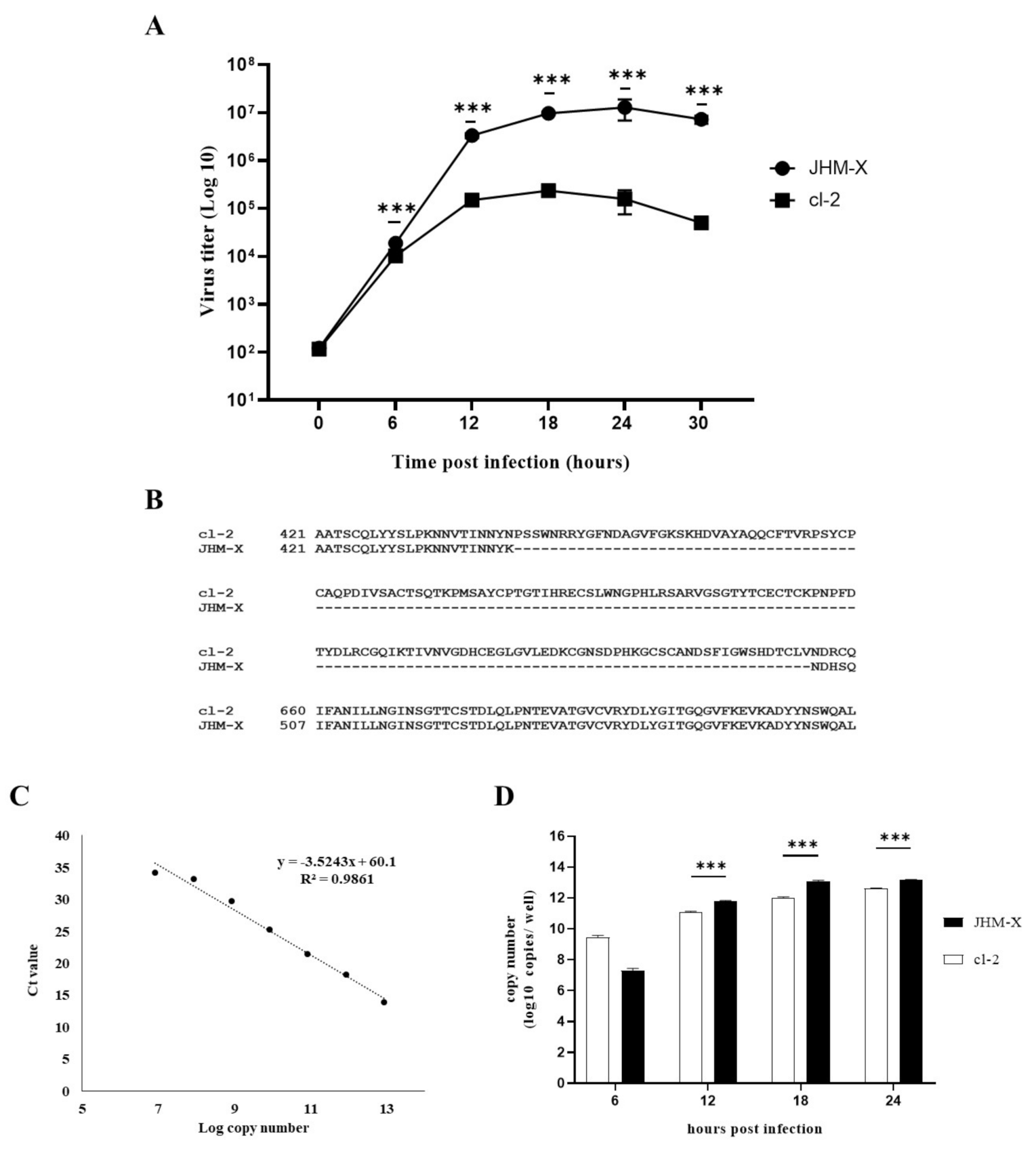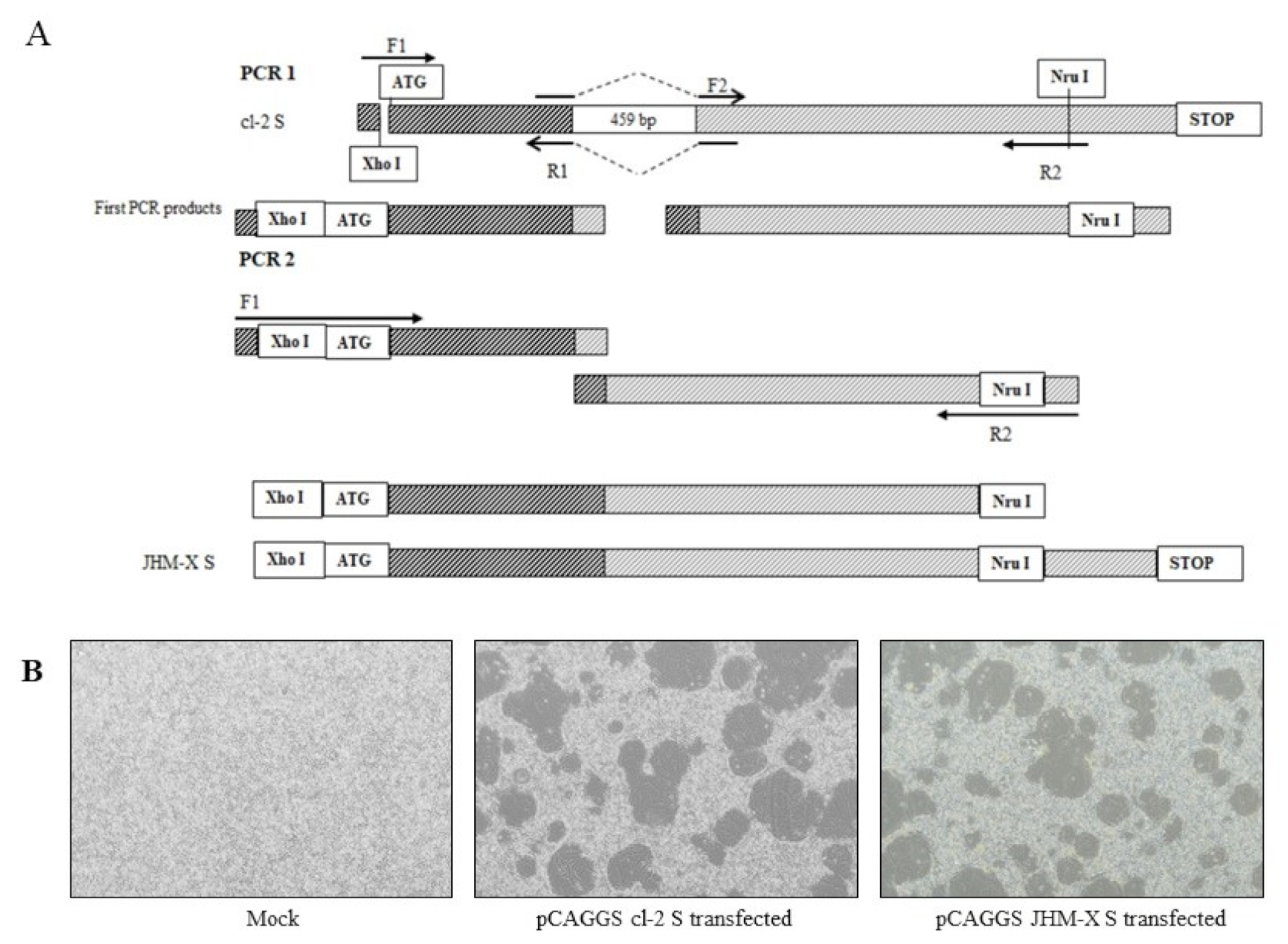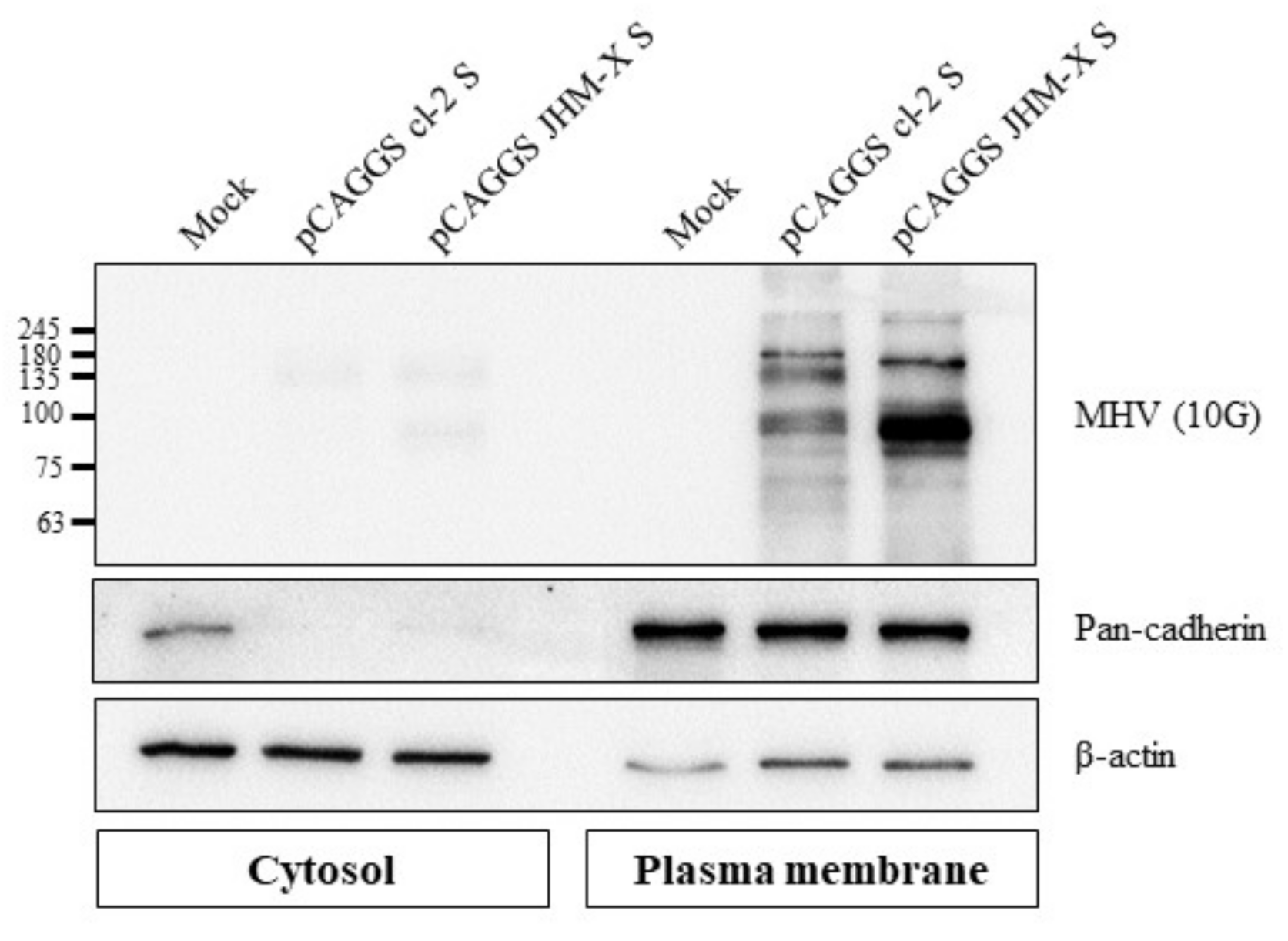Reduction of Cell Fusion by Deletion in the Hypervariable Region of the Spike Protein of Mouse Hepatitis Virus
Abstract
:1. Introduction
2. Materials and Methods
2.1. Cells and Viruses
2.2. RT-qPCR for Virus Growth Comparison
2.3. Syncytium (Plaque) Size and Quantification of Nucleus Number Inside a Plaque
2.4. Plasmid Construction
2.5. Transfection and Virus Infection
2.6. Western Blotting
2.7. Immunofluorescence Assay
2.8. Enzyme-Linked Immunosorbent Assay
2.9. Cell Fractionation and Surface-Expressed MHV Spike Protein Detection
2.10. Cell Fusion Assay
2.11. Quantification of Cell Fusion by Luciferase Activity
2.12. Statistical Analysis
3. Results
3.1. Virus Growth Comparison and Sequence Difference in the HVR of cl-2 and JHM-X
3.2. Plaque Size Comparison between the Two Viruses in DBT and BHKR1 Cells
3.3. Fusion Formation Comparison of Spike Proteins Expressed by the Two Strains
3.4. Quantification of Spike Protein Expression by Two Viruses
3.5. Cell Surface Expression of Spike Proteins from the Two Strains
3.6. Comparison of Cell Fusion Activity
3.7. Fusion Size Quantification Using Luciferase Activity
4. Discussion
5. Conclusions
Supplementary Materials
Author Contributions
Funding
Institutional Review Board Statement
Informed Consent Statement
Data Availability Statement
Conflicts of Interest
References
- Ouassou, H.; Kharchoufa, L.; Bouhrim, M.; Daoudi, N.E.; Imtara, H.; Bencheikh, N.; Elbouzidi, A.; Bnouham, M. The Pathogenesis of Coronavirus Disease 2019 (COVID-19): Evaluation and Prevention. J. Immunol. Res. 2020, 2020, 1357983. [Google Scholar] [CrossRef]
- Siddell, S.; Wege, H.; Ter Meulen, V. The Biology of Coronaviruses. J. Gen. Virol. 1983, 64, 761–776. [Google Scholar] [CrossRef] [PubMed]
- Wege, H.; Siddell, S.; ter Meulen, V. The Biology and Pathogenesis of Coronaviruses. In Current Topics in Microbiology and Immunology; Cooper, M., Henle, W., Hofschneider, P.H., Koprowski, H., Melchers, F., Rott, R., Schweiger, H.G., Vogt, P.K., Zinkernagel, R., Eds.; Springer: Berlin/Heidelberg, Germany, 1982; pp. 165–200. [Google Scholar]
- Smith, E.C.; Denison, M.R. Coronaviruses as DNA Wannabes: A New Model for the Regulation of RNA Virus Replication Fidelity. PLoS Pathog. 2013, 9, e1003760. [Google Scholar] [CrossRef] [PubMed] [Green Version]
- Parker, S.E.; Gallagher, T.M.; Buchmeier, M.J. Sequence analysis reveals extensive polymorphism and evidence of deletions within the E2 glycoprotein gene of several strains of murine hepatitis virus. Virology 1989, 173, 664–673. [Google Scholar] [CrossRef]
- Rowe, C.L.; Baker, S.C.; Nathan, M.J.; Fleming, J.O. Evolution of mouse hepatitis virus: Detection and characterization of spike deletion variants during persistent infection. J. Virol. 1997, 71, 2959–2969. [Google Scholar] [CrossRef] [Green Version]
- Sims, A.C.; Ostermann, J.; Denison, M.R. Mouse Hepatitis Virus Replicase Proteins Associate with Two Distinct Populations of Intracellular Membranes. J. Virol. 2000, 74, 5647–5654. [Google Scholar] [CrossRef] [PubMed] [Green Version]
- Matsuyama, S.; Taguchi, F. Communication between S1N330 and a Region in S2 of Murine Coronavirus Spike Protein Is Important for Virus Entry into Cells Expressing CEACAM1b Receptor. Virology 2002, 295, 160–171. [Google Scholar] [CrossRef] [Green Version]
- Navas, S.; Seo, S.-H.; Chua, M.M.; Sarma, J.D.; Lavi, E.; Hingley, S.T.; Weiss, S.R. Murine Coronavirus Spike Protein Determines the Ability of the Virus To Replicate in the Liver and Cause Hepatitis. J. Virol. 2001, 75, 2452–2457. [Google Scholar] [CrossRef] [PubMed] [Green Version]
- De Haan, C.A.M.; te Lintelo, E.; Li, Z.; Raaben, M.; Wurdinger, T.; Bosch, B.J.; Rottier, P.J.M. Cooperative Involvement of the S1 and S2 Subunits of the Murine Coronavirus Spike Protein in Receptor Binding and Extended Host Range. J. Virol. 2006, 80, 10909–10918. [Google Scholar] [CrossRef] [Green Version]
- Phillips, J.J.; Chua, M.; Seo, S.-H.; Weiss, S.R. Multiple regions of the murine coronavirus spike glycoprotein influence neurovirulence. J. NeuroVirol. 2001, 7, 421–431. [Google Scholar]
- Li, F. Structure, Function, and Evolution of Coronavirus Spike Proteins. Annu. Rev. Virol. 2016, 3, 237–261. [Google Scholar] [CrossRef] [Green Version]
- Gallagher, T.M.; Buchmeier, M.J. Coronavirus Spike Proteins in Viral Entry and Pathogenesis. Virology 2001, 279, 371–374. [Google Scholar] [CrossRef] [Green Version]
- Huang, Y.; Yang, C.; Xu, X.-F.; Xu, W.; Liu, S.-W. Structural and functional properties of SARS-CoV-2 spike protein: Potential antivirus drug development for COVID-19. Acta Pharmacol. Sin. 2020, 41, 1141–1149. [Google Scholar] [CrossRef]
- Dalziel, R.G.; Lampert, P.W.; Talbot, P.J.; Buchmeier, M.J. Site-specific alteration of murine hepatitis virus type 4 peplomer glycoprotein E2 results in reduced neurovirulence. J. Virol. 1986, 59, 463–471. [Google Scholar] [CrossRef] [Green Version]
- Fleming, J.O.; Trousdale, M.D.; el-Zaatari, F.A.; Stohlman, S.A.; Weiner, L.P. Pathogenicity of antigenic variants of murine coronavirus JHM selected with monoclonal antibodies. J. Virol. 1986, 58, 869–875. [Google Scholar] [CrossRef] [Green Version]
- Hofmann, H.; Hattermann, K.; Marzi, A.; Gramberg, T.; Geier, M.; Krumbiegel, M.; Kuate, S.; Überla, K.; Niedrig, M.; Pöhlmann, S. S Protein of Severe Acute Respiratory Syndrome-Associated Coronavirus Mediates Entry into Hepatoma Cell Lines and Is Targeted by Neutralizing Antibodies in Infected Patients. J. Virol. 2004, 78, 6134. [Google Scholar] [CrossRef] [Green Version]
- Taguchi, F.; Siddell, S.G.; Wege, H.; ter Meulen, V. Characterization of a variant virus selected in rat brains after infection by coronavirus mouse hepatitis virus JHM. J. Virol. 1985, 54, 429. [Google Scholar] [CrossRef] [Green Version]
- Taguchi, F.; Fleming, J.O. Comparison of six different murine coronavirus JHM variants by monoclonal antibodies against the E2 glycoprotein. Virology 1989, 169, 233–235. [Google Scholar] [CrossRef]
- Hirano, N.; Fujiwara, K.; Hino, S.; Matumoto, M. Replication and plaque formation of mouse hepatitis virus (MHV-2) in mouse cell line DBT culture. Arch. Virol. 1974, 44, 298–302. [Google Scholar] [CrossRef]
- Koetters, P.J.; Hassanieh, L.; Stohlman, S.A.; Gallagher, T.; Lai, M.M.C. Mouse Hepatitis Virus Strain JHM Infects a Human Hepatocellular Carcinoma Cell Line. Virology 1999, 264, 398–409. [Google Scholar] [CrossRef]
- Saeki, K.; Ohtsuka, N.; Taguchi, F. Identification of spike protein residues of murine coronavirus responsible for receptor-binding activity by use of soluble receptor-resistant mutants. J. Virol. 1997, 71, 9024–9031. [Google Scholar] [CrossRef] [PubMed] [Green Version]
- Taguchi, F.; Yamada, A.; Fujiwara, K. Resistance to highly virulent mouse hepatitis virus acquired by mice after low-virulence infection: Enhanced antiviral activity of macrophages. Infect. Immun. 1980, 29, 42–49. [Google Scholar] [CrossRef] [PubMed] [Green Version]
- Matsuyama, S.; Taguchi, F. Impaired entry of soluble receptor-resistant mutants of mouse hepatitis virus into cells expressing MHVR2 receptor. Virology 2000, 273, 80–89. [Google Scholar] [CrossRef] [Green Version]
- Routledge, E.; Stauber, R.; Pfleiderer, M.; Siddell, S.G. Analysis of murine coronavirus surface glycoprotein functions by using monoclonal antibodies. J. Virol. 1991, 65, 254–262. [Google Scholar] [CrossRef] [PubMed] [Green Version]
- Kubo, H.; Takase-Yoden, S.; Taguchi, F. Neutralization and fusion inhibition activities of monoclonal antibodies specific for the S1 subunit of the spike protein of neurovirulent murine coronavirus JHMV c1–2 variant. J. Gen. Virol. 1993, 74, 1421–1425. [Google Scholar] [CrossRef] [PubMed]
- Wang, H.; Li, X.; Nakane, S.; Liu, S.; Ishikawa, H.; Iwamoto, A.; Matsuda, Z. Co-expression of foreign proteins tethered to HIV-1 envelope glycoprotein on the cell surface by introducing an intervening second membrane-spanning domain. PLoS ONE 2014, 9, e96790. [Google Scholar] [CrossRef]
- Yamamoto, M.; Matsuyama, S.; Li, X.; Takeda, M.; Kawaguchi, Y.; Inoue, J.-I.; Matsuda, Z. Identification of Nafamostat as a Potent Inhibitor of Middle East Respiratory Syndrome Coronavirus S Protein-Mediated Membrane Fusion Using the Split-Protein-Based Cell-Cell Fusion Assay. Antimicrob. Agents Chemother. 2016, 60, 6532–6539. [Google Scholar] [CrossRef] [Green Version]
- Weiss, S.R.; Navas-Martin, S. Coronavirus pathogenesis and the emerging pathogen severe acute respiratory syndrome coronavirus. Microbiol. Mol. Biol. Rev. 2005, 69, 635–664. [Google Scholar] [CrossRef] [Green Version]
- Sánchez, C.M.; Izeta, A.; Sánchez-Morgado, J.M.; Alonso, S.; Sola, I.; Balasch, M.; Plana-Durán, J.; Enjuanes, L. Targeted recombination demonstrates that the spike gene of transmissible gastroenteritis coronavirus is a determinant of its enteric tropism and virulence. J. Virol. 1999, 73, 7607–7618. [Google Scholar] [CrossRef] [Green Version]
- Phillips, J.J.; Chua, M.M.; Lavi, E.; Weiss, S.R. Pathogenesis of Chimeric MHV4/MHV-A59 Recombinant Viruses: The Murine Coronavirus Spike Protein Is a Major Determinant of Neurovirulence. J. Virol. 1999, 73, 7752. [Google Scholar] [CrossRef] [Green Version]
- Leparc-Goffart, I.; Hingley, S.T.; Chua, M.M.; Phillips, J.; Lavi, E.; Weiss, S.R. Targeted recombination within the spike gene of murine coronavirus mouse hepatitis virus-A59: Q159 is a determinant of hepatotropism. J. Virol. 1998, 72, 9628–9636. [Google Scholar] [CrossRef] [Green Version]
- Song, H.C.; Seo, M.-Y.; Stadler, K.; Yoo, B.J.; Choo, Q.-L.; Coates, S.R.; Uematsu, Y.; Harada, T.; Greer, C.E.; Polo, J.M. Synthesis and Characterization of a Native, Oligomeric Form of Recombinant Severe Acute Respiratory Syndrome Coronavirus Spike Glycoprotein. J. Virol. 2004, 78, 10328–10335. [Google Scholar] [CrossRef] [Green Version]
- Petit, C.M.; Melancon, J.M.; Chouljenko, V.N.; Colgrove, R.; Farzan, M.; Knipe, D.M.; Kousoulas, K.G. Genetic analysis of the SARS-coronavirus spike glycoprotein functional domains involved in cell-surface expression and cell-to-cell fusion. Virology 2005, 341, 215–230. [Google Scholar] [CrossRef] [Green Version]
- Ou, X.; Liu, Y.; Lei, X.; Li, P.; Mi, D.; Ren, L.; Guo, L.; Guo, R.; Chen, T.; Hu, J. Characterization of spike glycoprotein of SARS-CoV-2 on virus entry and its immune cross-reactivity with SARS-CoV. Nat. Commun. 2020, 11, 1620. [Google Scholar] [CrossRef] [Green Version]
- De Groot, R.J.; Van Leen, R.W.; Dalderup, M.J.; Vennema, H.; Horzinek, M.C.; Spaan, W.J. Stably expressed FIPV peplomer protein induces cell fusion and elicits neutralizing antibodies in mice. Virology 1989, 171, 493–502. [Google Scholar] [CrossRef]
- Gombold, J.L.; Hingley, S.T.; Weiss, S.R. Fusion-defective mutants of mouse hepatitis virus A59 contain a mutation in the spike protein cleavage signal. J. Virol. 1993, 67, 4504–4512. [Google Scholar] [CrossRef] [Green Version]
- Gallagher, T.M.; Parker, S.E.; Buchmeier, M.J. Neutralization-resistant variants of a neurotropic coronavirus are generated by deletions within the amino-terminal half of the spike glycoprotein. J. Virol. 1990, 64, 731. [Google Scholar] [CrossRef] [Green Version]







| Primer | Nucleotide Sequences |
|---|---|
| Forward 1 (F1) | 5′ TACCCGGGCATGCTCGAGATGCTGTTCGTCTTTATTTTACTATT 3′ |
| Forward 2 (F2) | 5′ GTTACCATAAATAACTATAAAAATGATCACTCACAAATTT 3′ |
| Reverse 1 (R1) | 5′ AAATTTGTGAGTGATCATTTTTATAGTTATTTATGGTAAC 3′ |
| Reverse 1 (R2) | 5′ TCGCGAACTTCTTGACCACCAGTGCAATTG 3′ |
Publisher’s Note: MDPI stays neutral with regard to jurisdictional claims in published maps and institutional affiliations. |
© 2022 by the authors. Licensee MDPI, Basel, Switzerland. This article is an open access article distributed under the terms and conditions of the Creative Commons Attribution (CC BY) license (https://creativecommons.org/licenses/by/4.0/).
Share and Cite
Tennakoon, N.; Ryu, J.; Ujike, M.; Taguchi, F.; Shin, H.-J. Reduction of Cell Fusion by Deletion in the Hypervariable Region of the Spike Protein of Mouse Hepatitis Virus. Viruses 2022, 14, 398. https://doi.org/10.3390/v14020398
Tennakoon N, Ryu J, Ujike M, Taguchi F, Shin H-J. Reduction of Cell Fusion by Deletion in the Hypervariable Region of the Spike Protein of Mouse Hepatitis Virus. Viruses. 2022; 14(2):398. https://doi.org/10.3390/v14020398
Chicago/Turabian StyleTennakoon, Nipuna, Jihoon Ryu, Makoto Ujike, Fumihiro Taguchi, and Hyun-Jin Shin. 2022. "Reduction of Cell Fusion by Deletion in the Hypervariable Region of the Spike Protein of Mouse Hepatitis Virus" Viruses 14, no. 2: 398. https://doi.org/10.3390/v14020398
APA StyleTennakoon, N., Ryu, J., Ujike, M., Taguchi, F., & Shin, H.-J. (2022). Reduction of Cell Fusion by Deletion in the Hypervariable Region of the Spike Protein of Mouse Hepatitis Virus. Viruses, 14(2), 398. https://doi.org/10.3390/v14020398








